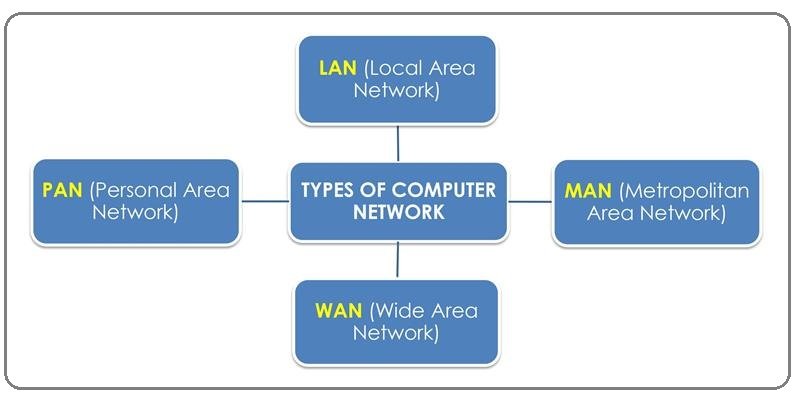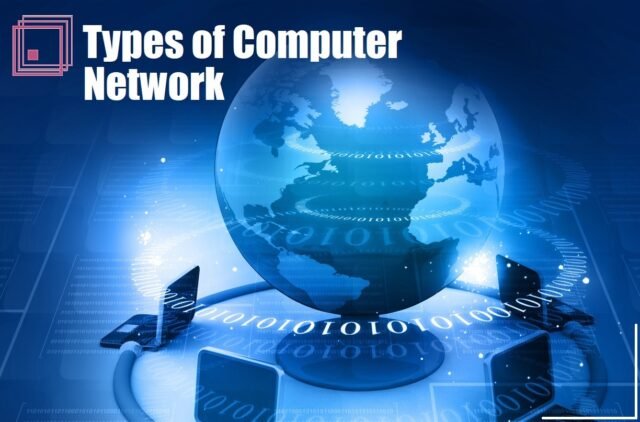Types of Computer Network
A network may be a small group of interlinked computers to a chain of a few hundred computers of different types, for example personal computers, minicomputers, mainframes etc. A Computer Network is a group of computers linked to each other that enables the computer to communicate with another computer and share their resources, data, and applications. These computers may be localised or spread around the world. Thus networks vary in terms of their size and complexity.
LAN (Local Area Network)
- In a LAN, network devices are connected over a relatively short distance.
- They are generally privately owned networks within a single building or campus, of up to a few kilometres in size.
- LANs can be small, linking as few as three computers, but often link hundreds of computers used by thousands of people.
- Many users can share expensive devices, such as laser printers, as well as data on the LAN.
- Users can use the LAN to communicate with each other, by sending mails or engaging in chat sessions.
- Nowadays we also have WLAN (Wireless LAN) which is based on wireless network.
- One LAN can even be connected to other LANs over any distance via telephone lines and radio waves.
- There is also a limit on the number of computers that can be attached to a single LAN.
- The development of standard networking protocols and media has resulted in worldwide proliferation of LANs throughout business and educational organizations.
PAN (Personal Area Network)
- A Personal Area Network is a computer network organized around an individual person.
- Personal Area Networks typically involve a mobile computer, a cell phone or a handheld computing devices.
- We can use these networks to transfer files including email and calendar appointments, digital photos and music.
- Personal Area Networks can be constructed with cables or be wireless.
- USB and FireWire technologies often link together a wired PAN, while wireless PANs typically use bluetooth or sometimes infrared connections. Bluetooth PANs generally cover a range of less than 10 meters (about 30 feet).
- PANs can be viewed as a special type (or subset) of local area network (LAN) that supports one person instead of a group.
MAN (Metropolitan Area Network)
- This is basically a bigger version of LAN and normally uses similar technology.
- It might cover few buildings in a city and might either be private or public.
- This is a network which spans a physical area ( in the range of 5 and 50 km diameter) that is larger than a LAN but smaller than a WAN.
- MANs are usually characterized by very high-speed connections using optical fibres or other digital media and provides uplink services to Wide Area Networks (WANs) and the Internet.
- In a city, a MAN, which can support both data and voice might even be related to local cable television network.
- The MAN, its communications links and equipment are generally owned by either a consortium of users or by a single network provider who sells the service to the users.
- Since MAN adopts technologies from both LAN and WAN to serve its purpose, it is also frequently used to provide a shared connection to other networks using a link to a WAN.
WAN (Wide Area Network)
- WAN spans a large geographical area, often a country or a continent.
- It uses various commercial and private communication lines to connect computers.
- WAN combines multiple LANs that are geographically separated. This is accomplished by connecting the different LANs using services such as dedicated leased phone lines, dial-up phone lines, satellite links, high speed fibre optic cables and data packet carrier services.
- Wide area networking can be as simple as a modem and remote access server for employees to dial into.
- It can be as complex as hundreds of branch offices globally linked using special routing protocols and filters to minimize the expense of sending data sent over vast
distances. - Local telephone exchange is a part of WAN. The computers at each telephone exchange connect to other exchanges to allow you to talk to people all over the world.
- The internet is the largest WAN, spanning the entire earth.

also read:
| HTML | DATA STRUCTURE |
| DBMS | REASONING |
| C PROGRAM | APTITUDE |
| E-LEARNING |







